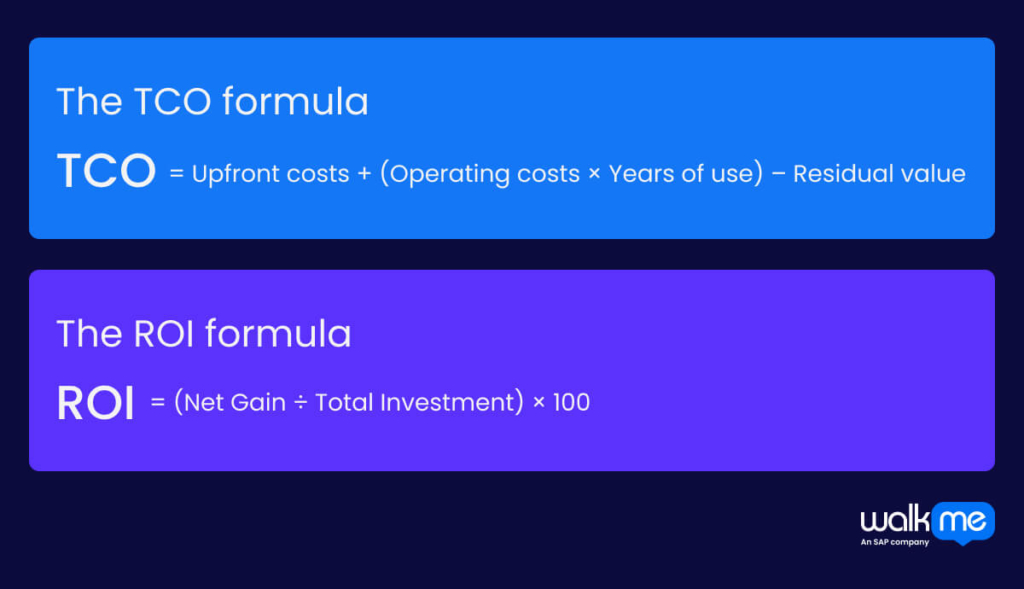You’ve probably heard both total cost of ownership (TCO) and return on investment (ROI) when evaluating technology and business investments. Both measure value, and misunderstanding their purpose can lead to costly decisions.
Gartner found that only 48% of digital initiatives achieve their intended outcomes, highlighting how both ROI and TCO are often underestimated or miscalculated.

Understanding the difference between them is key to making informed enterprise technology buying decisions.
This article explores TCO vs. ROI, explaining how each works and how to use both to make smarter IT investment decisions.
What is TCO?
Total cost of ownership (TCO) is the full amount a business pays for technology over its entire life cycle. It measures the financial reality of using technology over time, rather than just the cost you see at the point of purchase. Long-term commitments often shape business outcomes, and TCO estimates make those impacts visible.
Leaders need to account for post-implementation investments, making this measure essential for understanding the full financial impact. This provides a clearer picture of sustainability, risk, and financial exposure before any decision is made.
An example of TCO might include calculating the costs of licences, integration work, ongoing administration, vendor support fees, and the effort required to keep the technology functional across its operational life.
What is ROI?
Return on investment (ROI) is the value a business earns relative to the cost of achieving it. The term covers any measurable result that shows investments delivered value, such as higher revenue, lower costs, or better performance.
Understanding ROI is crucial in today’s complex IT environments, where multiple systems and vendors are interconnected, and every investment must deliver clear value.
Examples include savings from reducing manual admin, financial benefits from consolidating tools, and productivity gains that allow teams to focus on higher-value work.
What are the differences between TCO and ROI?
Businesses often confuse or merge TCO and ROI when evaluating technology performance or investments. Understanding the differences between the two can be challenging, especially for those who aren’t well-versed in calculating financial business metrics.
The table below highlights the differences between TCO and ROI:
| Aspect | Total Cost of Ownership (TCO) | Return on Investment (ROI) |
| Focus | Full cost of ownership across the asset’s life | Net financial gain after deployment |
| Scope | All spending is tied to acquiring, running, and retiring technology | Only measurable returns are attributed to the investment |
| Purpose | Reveal hidden burdens before approval | Confirm whether the value materializes |
Focus
TCO captures the complete financial commitments of a technology over its lifecycle, from purchase to retirement. ROI evaluates the effectiveness of that investment by measuring the benefits or gains achieved relative to its cost.
Scope
The scope of TCO spans across all associated expenses. These usually include licences, integrations, maintenance, and operational overhead.
ROI concentrates only on measurable outcomes, such as revenue gains, cost savings, and efficiency improvements. Understanding the difference in scope ensures the financial burden of ownership and the tangible value returned is understood.
Purpose
The purpose of TCO is to highlight hidden costs and expenses that reveal the financial commitment before approving a purchase. ROI confirms whether the said investment generated the expected value. Both help leaders justify spending and make data-driven decisions that optimize cost management and returns.
What are the key components of TCO?
To really understand TCO, you need to take a holistic view of the key components. This means considering all of the costs below to give you a genuine view of financial burdens tied to operating technology:
- Acquisition costs: Upfront spend on licences, hardware, and procurement fees to secure the technology.
- Implementation costs: The labor and tooling needed to configure, integrate, and test the system.
- Operational costs: Everyday running expenditure such as compute, data usage, hosting, backups, and admin.
- Maintenance costs: Ongoing patching, version updates, capacity adjustments, and regulatory alignment work.
- Support costs: Service desk load, vendor escalation fees, and troubleshooting effort when incidents occur.
- Training costs: Onboarding time, investments in a digital adoption platform (DAP), and productivity dips as users learn the system.
- Decommissioning costs: The extraction, sanitisation, and retirement tasks needed to shut the system down cleanly.
- Opportunity costs: Value never captured because resources were tied up in the investment you’re calculating TCO for.
What are the key components of ROI?
The components of ROI below capture all the factors that determine whether an investment delivers real value and are a starting point for accurately calculating returns:
- Direct financial benefits: Revenue gained or costs saved directly from the investment.
- Operational efficiency: Process improvements that reduce time and resource use.
- Strategic value: Long-term advantages that strengthen business positioning.
- Payback period: Time needed to recover the initial investment.
- ROI Calculations: Dividing net gains by total investment to show the percentage return.
How do you calculate TCO and ROI?
TCO and ROI calculations measure different aspects of an investment, and are inextricably linked. TCO establishes the real cost of ownership, which ROI then uses to determine the return.

The TCO formula
- TCO = Upfront costs + (Operating costs × Years of use) – Residual value
Example
A business buys an AI automation tool and wants to know the real ownership cost over five years. These are the cost items that must be added:
- Software licence: $10,000
- Implementation: $20,000
- Training: $10,000
- Support and updates: $10,000
- Expected life: 5 Years
Applying the formula:
TCO = $10,000 + $20,000 + $10,000 + $10,000 = $50,000
The total TCO over 5 years is $50,000.
Dividing by the expected life gives the average annual cost: $50,000 ÷ 5 = $10,000 per year.
The ROI formula
ROI = (Net Gain ÷ Total Investment) × 100
This formula calculates the percentage return on an investment by comparing the profit earned (net gain) to the total amount spent (total investment).
Example
Using the $50,000 TCO from the previous example as the total investment over the same five-year period:
Value gained from the tool:
- Admin time saved: $40,000
- Less rework needed: $30,000
- Total measurable value: $70,000
Applying the formula:
Net gain = Total value − Total investment = $70,000 − $50,000 = $20,000
ROI = Net gain ÷ Total investment = $20,000 ÷ $50,000 = 0.40, or 40%
Therefore, ROI = 40%. This shows that for every dollar spent, the business gained $0.40 in measurable value over the same period.
Scenarios to use TCO
TCO can be used in a range of different scenarios, including:
Comparing different cost models
TCO allows you to evaluate different cost models, such as per-user licensing, subscription tiers, or pay-as-you-go cloud plans:
- Break down each model into its full lifecycle costs.
- Sum upfront fees, recurring charges, support, and end-of-life expenses.
- Compare totals to see which approach is cost-effective over time.
- Highlight options that remain sustainable.
TCO makes it clear which pricing approach costs more over time. For example, a per-user subscription might seem cheaper initially, but recurring costs can quickly add up. Flat-rate licenses with higher upfront costs can work out more affordable in the long run, and TCO helps reveal the full picture.
Planning and forecasting spend
Using TCO for planning involves accounting for every expected expense across the technology’s lifespan:
- List all costs, including licences, implementation, maintenance, and training.
- Assign numeric values to each item to make them measurable.
- Combine numbers to produce a comprehensive projected spend.
- Use the total to guide financial decision-making.
Looking at TCO helps leaders see how recurring costs affect budgets. Adequate planning in this stage reveals both predictable and hidden expenses and ensures funds are available when needed, reducing surprises throughout the system’s lifecycle.
Revealing overlooked expenses
TCO helps ensure no hidden costs are missed during evaluations:
- Collect all potential costs, including those not immediately visible.
- Record each expense to avoid omissions.
- Review contracts, support plans, and operational requirements for gaps.
- Include all items in the total to present a complete financial picture.
Small or unexpected costs can quickly add up and are easy to miss. TCO can identify needs, such as additional training or decommissioning tasks, and bring them into a single view. Understanding the true burden of IT investments means looking beyond the initial scope.
Testing long-term affordability
TCO provides a framework for assessing sustainability across years:
- Project costs over the asset’s expected life, factoring in updates and scaling.
- Include recurring fees, vendor escalations, and depreciation.
- Aggregate these projected costs into a single figure.
- Use this total to determine whether the investment remains manageable.
TCO confirms whether a technology is sustainable as it grows and scales. Factoring in these costs shows whether the investment can be sustained without straining the budget and helps leaders plan for future expansion.
Scenarios to use ROI
ROI can be used in a range of different scenarios, including:
Revenue-focused investments
Using ROI to assess revenue-focused investments gives a clear picture of which initiatives generate the most money:
- Compare projected revenue with total costs to spot the biggest gains.
- Subtract investment from expected income to find net gain.
- Divide net gain by total spend to get ROI as a percentage.
- Rank initiatives to see which revenue streams to prioritize.
ROI is a clear indicator of which initiatives generate the most value relative to cost. When assessing a technology investment, comparing projected revenue or cost savings against total spend shows which initiatives are delivering the most gains. This ensures that focus remains on investments that make the most financial sense.
Project prioritization
ROI helps you rank projects by comparing the value they create against their costs. For each project:
- List all costs and expected returns.
- Subtract spend from forecasted returns to calculate net gain.
- Divide the net gain by the investment to calculate the ROI percentage.
- Categorize projects to focus on the highest-return efforts.
ROI helps rank projects by efficiency and impact. Higher-return initiatives should be completed first, ensuring resources aren’t wasted on low-value tasks. It also clarifies trade-offs when multiple projects compete for attention.
Growth-impact initiatives
For growth-impact initiatives, ROI shows the financial effect of scaling. To do this correctly:
- Add up all costs for the growth initiative.
- Estimate revenue growth over time, not just immediate gains.
- Subtract investment from total expected benefits for net gain.
- Divide net gain by spend to calculate ROI percentage.
Scaling projects can be costly, and ROI shows whether expansion is worthwhile. For example, using ROI to measure projected revenue gains over time helps inform decisions on which initiatives deliver the greatest financial benefits and which strain budgets prematurely.
Stakeholder justification
ROI provides a single metric that helps stakeholders see the value of a project before committing resources:
- Outline all costs that stakeholders need to approve.
- Collect projected returns relevant to their decisions.
- Calculate net benefit by subtracting spend from expected gains.
- Express net benefit as a percentage to give stakeholders a clear ROI metric.
Using ROI to present net gains as a percentage of total spend helps stakeholders understand whether an investment is worth supporting. Clear metrics for decision-makers and stakeholders lead to quicker approvals and a reduced risk of project stagnation.
Final thoughts on using TCO and ROI together
As you’ve read, TCO and ROI are interconnected and inform each other in fundamental ways.
Using these financial metrics properly, understanding their differences, and obtaining the right numbers are the only ways leaders can accurately assess whether an investment is worthwhile.
One more thing to consider is that calculating TCO first ensures ROI reflects the real cost of ownership. If the numbers aren’t correct, ROI can give a misleading picture of profitability, making it easy to overestimate returns.
Leaders should use both TCO and ROI as part of a wider digital transformation roadmap, where digital adoption ensures value is realized and ultimately accelerates financial transformation.
FAQs
Start by defining your decision goal. Use TCO to see the full, ongoing cost of a SaaS tool over time, including hidden fees. Use ROI to estimate the tangible benefits and value created. Together, they show which investments are affordable and deliver measurable outcomes.
TCO matters most when long-term costs outweigh short-term gains. For IT systems that require ongoing subscriptions, support, or maintenance, understanding TCO prevents surprises, ensures budget accuracy, and helps leaders plan sustainably, even when immediate ROI looks attractive.
Evaluating both means organizations balance spending with expected value. TCO shows full cost exposure, and ROI shows anticipated benefits. Comparing them highlights which initiatives deliver true value for the money and which could strain budgets, helping leaders allocate resources wisely and plan for sustainable technology adoption.

